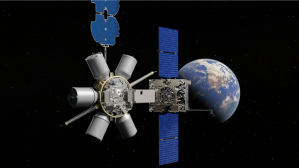SpaceX launches 2 US military payloads for Arctic connectivity

SpaceX successfully launched a pair of satellites for Space Norway on Friday that also included two U.S. military payloads designed to enable enhanced connectivity in the Arctic region.
The Arctic Satellite Broadband Mission (ASBM) constellation, which includes two sats, was sent into orbit via a Falcon 9 rocket from Vandenberg Space Force Base, California. The systems — built by Northrop Grumman — will operate in a highly elliptical orbit and provide comms for both commercial and military applications in the High North, according to a company press release.
The launch marks the first time an operational U.S. military payload is being hosted on a commercial satellite operated by a foreign partner, according to the Space Force — a key milestone in the United States’ effort to strengthen collaboration with international allies in the space domain.
Included in the constellation are two Enhanced Polar System — Recapitalization (EPS-R) secure communications payloads for the U.S. Space Force. Also built by Northrop Grumman, the payloads will extend current satellite communications capability in the Arctic region until the service’s next-generation Protected Tactical SATCOM (PTS) system is fielded in the early 2030s, according to the Department of Defense.
“Northrop Grumman’s end-to-end mission expertise and proven ability to deliver cutting-edge technology on orbit enables our customers’ most challenging missions,” Rob Fleming, corporate vice president and president of Northrop Grumman Space Systems, said in a statement. “Our team came together at every stage of design, test and integration to bring commercial broadband and protected military satellite communications to the Arctic for many years to come.”
Improving connectivity in the austere Arctic region is a centerpiece of the Defense Department’s 2024 Arctic Strategy, published in July. The strategy calls on the Pentagon to leverage space-based communications infrastructure that can bolster its ability to operate in environments above 65 degrees North latitude.
“In addition to military satellite communications solutions to improve tactical and strategic communications, specifically above 65 degrees North latitude, DoD should pursue technology through commercial partners and agreements with NATO Allies and partners,” the strategy stated.
Space Norway is a state-owned firm that manages and develops space-based infrastructure and services for government and commercial uses. Along with the two EPS-R payloads for the Space Force, the ASBM constellation also includes an X-band payload for Norway’s armed forces and a Ka-band payload for commercial satellite operator Viasat, according to Northrop Grumman.
A company fact sheet noted that a secure payload interface isolates the EPS-R payloads from the rest of the satellite constellation, “paving the way for future hybrid military-commercial launches and bringing down the cost of distributing capabilities.”






